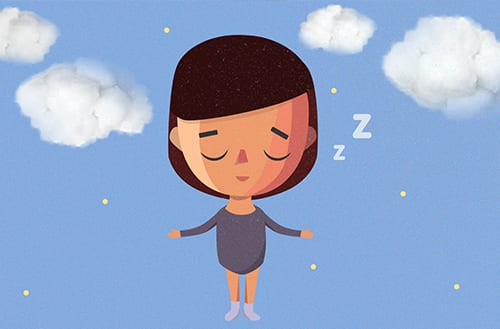Original Article | Thrive Global | April 3, 2019 | Author Stephanie Fairyington
Illustration by Joamir Salcedo
These 5 methods are working wonders
My 3-year-old daughter, Marty, flails around with monkey-like madness from the moment her eyes blink open in the morning to the moment we crack open our first book at bedtime. Taming her wild energy so she’s sleep-ready has been the challenge of my life this past year. But working at Thrive, where we’re encouraged to adopt small, actionable changes called Microsteps to make a huge cumulative impact on our lives, inspired me to consider whether or not I could introduce tiny modifications to our bedtime ritual to tranquilize her (naturally). It took more than a week before my efforts started paying off, but here’s how I’m doing it.
Read books in an ASMR voice
Autonomous Sensory Meridian Response (ASMR) is a phenomenon that elicits a tingling sensation in the body that relieves stress and induces sleep, according to science. To induce this feeling, the ASMR-sensitive watch videos of people whispering and moving very, very slowly. To help bring down Marty’s energy, I started reading books in a similar style. At first she fought it — “No, mama Steph, not like that!” — and wiggled around tirelessly with her legs crawling up the wall, but three days into the practice she seemed to accept and benefit from it.
Start a gratitude ritual
Because studies show that a pre-bedtime gratitude practice improves sleep quality and our sense of well-being, after the lights go out — and in my best ASMR-voice — I tell Marty the three things I’m grateful for and ask her to do the same.
Be still
This one gets the most resistance, but I modeled it for her for one minute every night for about a week and a half, and one evening she was tired and sluggish enough to be still too, which she’s (spottily) getting in the habit of doing, even if she only makes it to 10 seconds.
Take three deep breaths
This one I stole from our editorial meetings at Thrive, which frequently begin with a “centering protocol” that includes three deep breaths, led by our Deputy Editor, Emily Johnson. Research demonstrates the effectiveness of this practice for inducing shuteye, so I thought it might be a particularly useful practice for Marty to adopt. While she doesn’t quite understand how to do this yet — she just makes a lot of noise pushing air from her nose — she’s recently begun watching me breathe, transfixed, and vicariously reaches a mellow state by witnessing mine.
Visualize something that brings you peace
Finally, I walk her through a visualization of some of our best memories as a family on Cape Cod in the summer. First, we hit the Provincetown Public Library, which houses a huge (real-life!) ship in the center of one room, amazing toys and beautiful picture books. After we play in that pleasant memory, I “walk” her outside, where’s it’s 65 degrees, sunny and breezy. We get ice cream cones and walk to the beach, where we lay down under a soft warm sun — “and build sandcastles,” Marty says at this point. Then, after about five more minutes of tossing and turning, she falls fast asleep.

